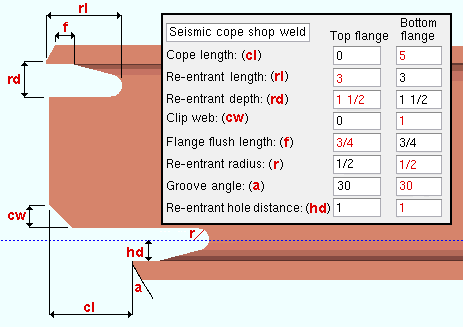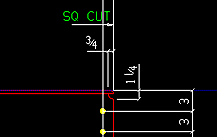"  End preparations " (for member main material)
End preparations " (for member main material)
On this page :
- General information about " End preparation " options
- Member main material
Also see :
- Rolled Section Material (another place with end preparations)
- Weld Design Settings (setup for weld preparation)
beam | column | vbrc | hbrc | girt (legacy) | purlin
General information about end preparations :
Q. Where are end preparations found?
A . An " ![]() End preparations " leaf can be found under " Left end settings " and " Right end settings " on the Beam Review , Column Review , Vertical Brace Review , Horizontal Brace Review , Girt (Legacy) Review and Purlin Review windows.
End preparations " leaf can be found under " Left end settings " and " Right end settings " on the Beam Review , Column Review , Vertical Brace Review , Horizontal Brace Review , Girt (Legacy) Review and Purlin Review windows.
Q. What do end preparations do?
A . " ![]() End preparations " control the end preparation on the left and right ends of a member's main material. In a full-featured SDS2 program , these fields may automatically be filled out by connection design .
End preparations " control the end preparation on the left and right ends of a member's main material. In a full-featured SDS2 program , these fields may automatically be filled out by connection design .
beam | column | vbrc | hbrc | girt (legacy) | purlin | top
---- Member main material ----
End-cut type: Standard cut or Square cut or Bevel cut or Mill cut .
|
During automatic detailing of members in a full-featured SDS2 program , an annotation specifying the end cut will be applied to the detail if the " End-cut type " is a choice other than ' Standard cut '. |
' Standard cut ' instructs automatic detailing in a full-featured SDS2 program to not annotate the member detail with special cut instructions.
' Square cut ' or ' Bevel cut ' or ' Mill cut ' selected for a particular end of this member will instruct automatic detailing of that member in a full-featured SDS2 program to apply an annotation to that end of the member detail. The annotation will specify how that end of the member main material is to be cut ( i.e., "SQ CUT" or "BEV CUT" or "MILL CUT").
Also see: The " End-cut type " on this member's main material edit window will exactly match the choice made here so long as this member is up to date. The main material " End-cut type " sets the " Main material " to '
', whereas this option (on the member review window) keeps the " Main material " set at '
'.
Web cut angle: A positive or negative (-) angle from 89 to -89 degrees. Angles closer to zero than .057 degrees are rounded to zero. ' 0 ' specifies that no web cut be made.
| left | right | left & right | left | right |
-10 degrees
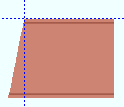 |
-10 degrees
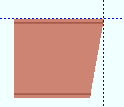 |
0 degrees
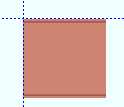 |
10 degrees
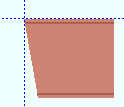 |
10 degrees
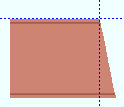 |
Assuming that you are viewing the near side of the member main material, a positive angle is measured counterclockwise from a perpendicular bisector to the workline. A negative (-) angle is measured clockwise from a perpendicular bisector to the workline.
Flange cut angle: A positive or negative (-) angle from 89 to -89 degrees. This is the angle at which both the near and far side of the flange are to be cut. ' 0 ' designates that no flange cut be made. Also see: ' Clip flange '.
| wide flange | ||||
| left | right | left & right | left | right |
-10 degrees
 |
-10 degrees
 |
0 degrees
 |
10 degrees
 |
10 degrees
 |
| angle (or channel) | ||||
| left | right | left & right | left | right |
-10 degrees
 |
-10 degrees
 |
0 degrees
 |
10 degrees
 |
10 degrees
 |
Assuming that the left end of the flange is to your left in your current view, a ' positive angle ' is measured counterclockwise from a perpendicular bisector to the flange center line. A ' negative (-) angle ' is measured clockwise from a perpendicular bisector to the flange center line.
Moment connection web setback: The distance that the web of this member main material is set back. This applies when ' Cope shop weld #3 (Standard) ' or ' Cope field weld #3 (Standard) ' or ' Cope field weld #1 (FEMA) ' or ' Cope shop weld #1 (FEMA) ' or ' Seismic cope field weld ' or ' Seismic cope shop weld ' is the " Top operation " or the " Bottom operation ."

|
s = moment connection web setback. |
Also see: A web setback applied here overrides the choice made to " Web setback dimension for moment connections " in Weld Design Settings. For a seismic connection, it overrides the " Web Setback " in Seismic Weld Access Holes .
Top/bottom flange operation: None or Cope plain or Cope shop weld #3 (Standard) or Cope field weld #3 (Standard) or Cut flange flush or Clip flange or Notch top/bottom or Notch near side/far side or Cope field weld #1 (FEMA) or Cope shop weld #1 (FEMA) or Clip web or Seismic cope field weld or Seismic cope shop weld .
' None ' designates that no top/bottom flange cutting operation be performed on this member's main material.
' Cope plain ' or ' Cope shop weld #3 (Standard) ' or ' Cope field weld #3 (Standard) ' designates weld preparation and / or a cut to remove part of the top/bottom flange plus part of the web. ' Cope shop weld #3 (Standard) ' or ' Cope field weld #3 (Standard) ' work best for wide flange or S Shape or W tee or S tee main material; ' Cope plain ' works for all material types. Tip: A " Cope length " of ' 0 ' for ' Cope shop weld ' or ' Cope field weld ' causes weld preparation without a coping operation.
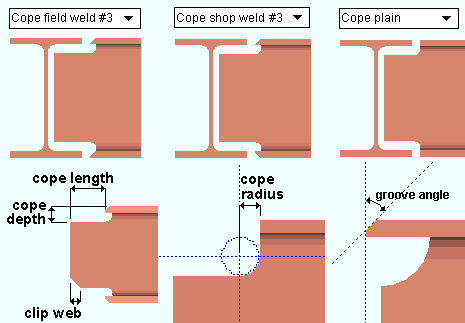
" Cope length " is the distance parallel with the main material's longitudinal axis ( X material axis ) from the (left or right) end of the member to the flange. Entries must either be ' 0 ' or greater than or equal to '1/2' inch ('13' mm).
" Cope depth " is the distance from the top of the top flange (or bottom of the bottom flange) into the web of the material. The cope depth is measured parallel with the " Web cut " angle, or -- for ' Cope plain ', if the " Cope cut type " is ' Parallel to flange ' -- it is measured perpendicular to the flange.
" Cope radius Setup: operation." Cope plain " sets the curvature at the corner for a " Home > Project Settings > Fabricator > Member Detailing/Fabricator Options > the " Beams " section > " Cope radius ."
" Clip web " is an option when ' Cope shop weld #3 (Standard) ' is the selected " Top/bottom flange operation ."
" Groove angle " sets the angle of the flange bevel (in degrees).
' Cut flange width ' applies when a wide flange or S Shape or W tee or S tee " Section size " has been entered as the main material for this member. It designates two flange cuts, one on the near side and the other on the far side of the flange. For channel or angle member main material, it designates a single cut (on the flange or on one leg of the angle).
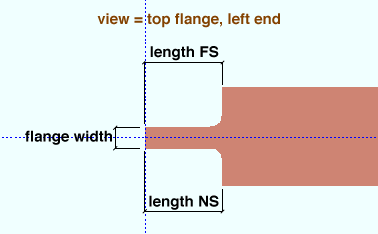
The ' Top/Bottom flange length NS ' is the distance from the (left or right) end of the member main material along the length of the near side of the top/bottom flange.
The ' Top/Bottom flange length FS ' is the distance from the (left or right) end of the member main material along the length of the far side of the top flange.
The ' Top/Bottom flange width ' is the flange width that remains after the NS and FS flange cuts are made.
' Cut flange flush ' applies when a wide flange or S Shape or W tee or S tee " Section size " has been entered for this member. It designates two flange cuts, one on the near side and the other on the far side of the flange, both cuts to the web. Entering ' 0 ' to the ' Length NS ' or ' Length FS ' field stops a cut from being made at that location. For channel or angle member main material, it specifies a single cut (on the flange or on one leg of the angle), and " Flange length NS " applies if the material is toe in, " Flange length FS " applies if the material is toe out.
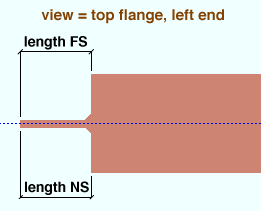
' Top/Bottom flange length NS ' is the distance from the (left or right) end of the material along the material's longitudinal axis ( X material axis ).
' Top/Bottom flange length FS ' is the distance from the (left or right) end of the material along the material's longitudinal axis ( X material axis ).
' Clip flange ' is for a wide flange or S Shape or W tee or S tee " Section size ." It designates a linear cut from the edge of the flange to the radius of the web at the angle designated by the field " Flange cut ." If the " Flange cut " is ' 0 ' or the " Section size " is angle , HSS round , HSS rectangular or channel , then a ' Clip flange ' does not take place.
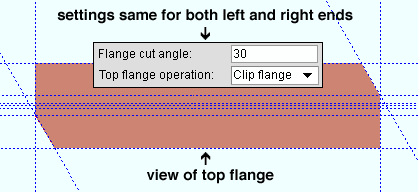
In this example, the " Flange cut " is positive. The left end clip is on the near side of the flange, while the clip on the right end is on the far side of the flange. ' Notch top ' or ' Notch bottom ' have distance entry fields for " Notch length " and " Notch width " and " Notch radius " and " Notch offset " that define the dimensions for a cut from the left/right edge of the HSS rectangular or HSS round material into the center of the member main material's top or bottom wall.
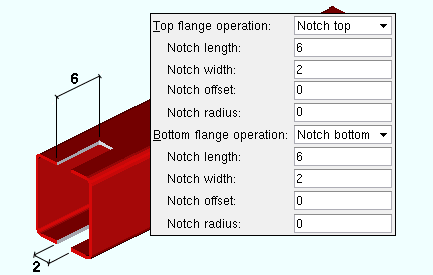
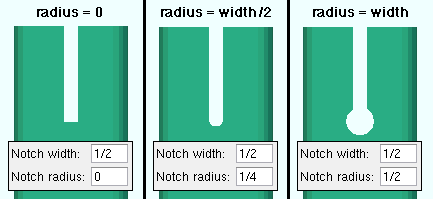
|
A " Notch radius " that is 1/2 the " Notch width " results in a half circle at the end of the slot. |
Setup: HSS notch radius (vertical braces), HSS notch radius (columns)
Setup: Total notch width clearance (vertical braces), Total notch width clearance (columns)' Notch near side ' or ' Notch far side ' have distance entry fields for " Notch length " and " Notch width " and " Notch radius " and " Notch offset " that define the dimensions for a cut from the left/right edge of the HSS rectangular or HSS round material into the center of the member main material's near side or far side wall.
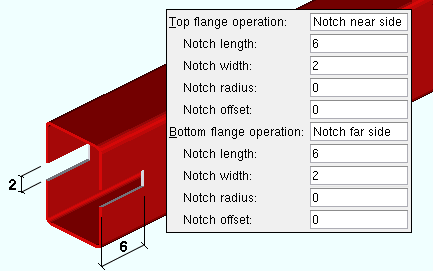
' Cope field weld #1 (FEMA) ' has distance entry fields for " Cope length ," " Re-entrant cut length ," " Re-entrant cut depth" " Flange flush length " " Re-entrant radius " " Groove angle ." Setup: " Alternate #1 re-entrant cut radius " " Groove angle " " Alternate #1 re-entrant cut length " " Alternate #1 re-entrant cut depth " " Alternate #1 flange flush length ."
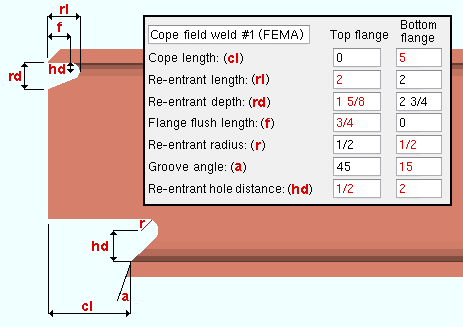
' Cope shop weld #1 (FEMA) ' has distance entry fields for " Cope length ," " Re-entrant cut length ," " Re-entrant cut depth " " Clip web " " Flange flush length " " Re-entrant radius " " Groove angle " " Re-entrant hole distance ." Setup: " Alternate #1 re-entrant cut radius " " Groove angle " " Alternate #1 re-entrant cut length " " Alternate #1 re-entrant cut depth " " Alternate #1 flange flush length ."
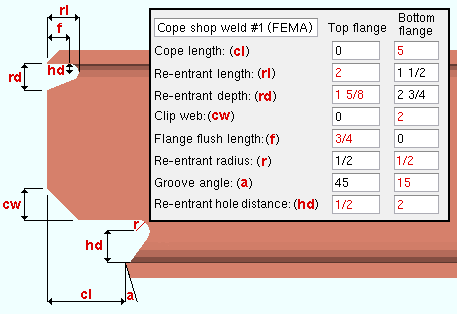
Clip web has distance entry fields for " Clip length " and " Clip depth ."
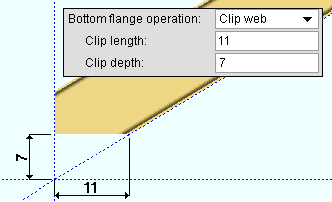
' Seismic cope field weld ' has distance entry fields for " Cope length ," " Re-entrant length ," " Re-entrant depth " " Clip web " " Flange flush length " " Re-entrant radius " " Groove angle " and " Re-entrant hole distance ." Setup: Seismic Weld Access Holes .
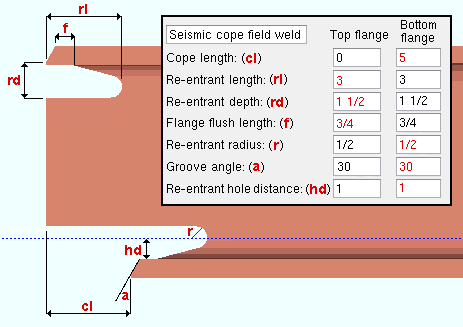
' Seismic cope shop weld ' has distance entry fields for " Cope length ," " Re-entrant length ," " Re-entrant depth " " Clip web " " Flange flush length " " Re-entrant radius " " Groove angle " " Re-entrant hole distance ." Setup: Seismic Weld Access Holes .
